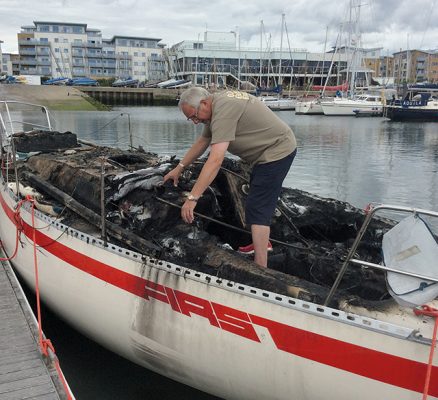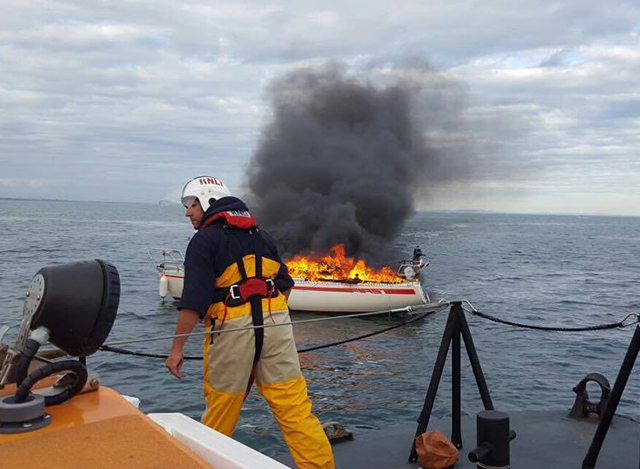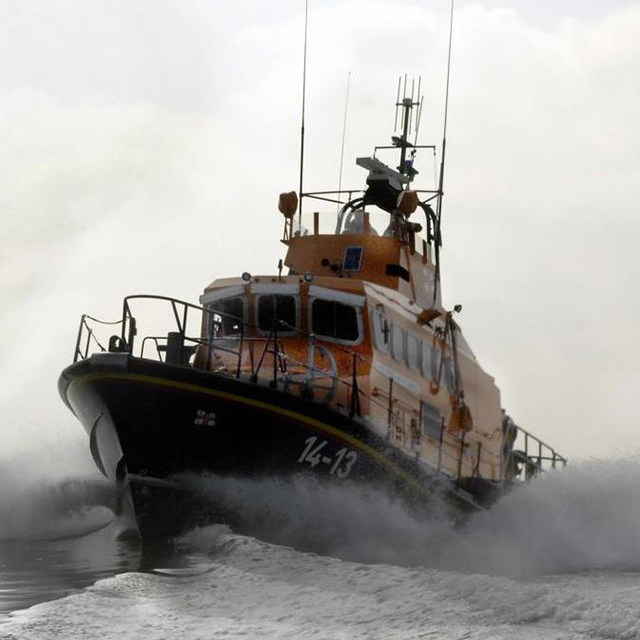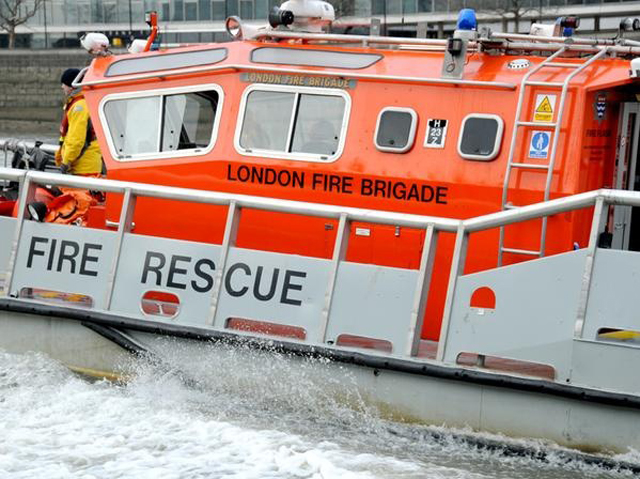‘Flames were licking out of the companionway’: yachtsman watched his beloved boat burn following two-year restoration
A couple forced to flee their burning yacht off the Dorset coast have praised rescuers and shared lessons learned from their ‘totally gutting’ experience in the latest issue of Practical Boat Owner magazine.
Maths teacher Robert Thornewill and his partner Thelma Bartlett were devastated to see Robert’s Beneteau First 30 yacht Eleanor C engulfed in flames from stem to stern after an engine fire broke out on approach to Poole Harbour.

Ablaze at the entrance to Poole Harbour.Credit: Poole Lifeboat Station
On 16 July, Robert and his partner Thelma Bartlett were motoring along the Swash Channel, following a shakedown sail to Studland Bay, when Thelma noticed smoke coming from the cabin.
Robert put the engine on tickover and with Thelma now at the helm, went to investigate.
‘The smoke was clearly coming from the engine compartment, so I reached for and armed one of the fire extinguishers on board.
However, my fire training from a previous career in REME (Royal Electrical and Mechanical Engineers) told me that opening the compartment would feed oxygen to the fire, so I left the engine hatch closed and grabbed the handheld radio to make the Mayday call.
‘I got Thelma to the bow – the furthest place from danger – and went back to launch the liferaft.’
Just then, Gary and Glenn Garraty on board their 25ft motor cruiser Knotty came alongside to offer assistance and said ‘get on here!’
Thelma and Robert stepped on board as flames were licking out of Eleanor C’s companionway.
The RNLI inshore lifeboat then arrived and the couple were transferred to the care of the RNLI crew who set up a cordon around Eleanor C, which was fully alight by this stage.
Within a few minutes, the RNLI all-weather boat arrived and started pumping water into Eleanor C to subdue the fire, while Robert and Thelma were transferred to Vanguard, the Poole pilot boat to be taken to Haven steps. The coastguard met them and they were taken to Poole Yacht Club (PYC) by road.
Meanwhile, with the fire essentially out, the RNLI towed the hull back to PYC where the fire service checked for any residual heat signatures.

Fire-damaged Eleanor C under tow. Credit: Poole Lifeboat Station
Robert had made certain all the circuits were suitably protected, and had even fitted extra 30A fuses near the batteries.
He said: ‘The only circuit that doesn’t have fuses in it is the charging circuit. I can only think that the regulator in the alternator failed and unregulated maximum current overwhelmed the wiring.’
Describing Eleanor C’s fire, he added: ‘I just feel totally gutted. I’d spent two years working on her. The last thing on the very long list was a bespoke teak cockpit’.
‘Like a flamethrower’
Robert thinks the fire escaped through the engine’s control panel and the solar panel regulator, and ‘became like a flamethrower’ when exposed to oxygen, arcing across the foam-backed roof panels.
‘It melted the new hatch and created a “wind tunnel” effect. The fire melted the base of the mast, which collapsed into the water’.
The situation would have been ‘far more serious’ without Knotty’s assistance, and Robert and Thelma have since thanked Gary and Glenn.

Salvaged belongings recovered from the yacht
The lifeboat volunteers managed to salvage house keys, car keys and even Thelma’s handbag from the interior, but other items such as phones, clothing and cameras were lost.
Robert is a long-standing member of the RNLI and says: ‘I feel it is incumbent on everyone on the water to be an RNLI member, because they are there when you need them most’.
When Robert said farewell the next day, he managed to salvage the ensign to grace his next boat, which will be called Spirit of Eleanor.
He may be retiring in two years time and is already looking for his next boat, and will be scouring the internet and Southampton Boat Show for one to last him out.

Thelma Bartlett and Robert Thornewill
Since the fire, Robert and Thelma have become engaged.
He said ‘This kind of experience tends to focus your life: things could easily have been different!’
Davis Jones, UK Coastguard spokesman, thanked everyone who assisted Eleanor C.
He said: ‘The two crew stayed calm under the circumstances and gave us accurate information about their location, which enabled the RNLI to reach them very quickly’.
Robert shares key lessons learned
1 – CREATE ACCESS FOR AN EXTINGUISHER TO THE ENGINE BAY: ‘An internal fire suppression system is expensive to retrofit, but an easy solution would be to have a small access hole covered by a flap, through which a fire extinguisher could be discharged into the engine bay, without opening the bay.’
2 – HAVE A GRAB BAG! ‘I didn’t have one, but I will in future. It will contain wallets, phones, keys, a fully charged handheld radio and bottled water. It will save a great deal of the hassle we went through.’

In happier times – Eleanor C before the fire
As published in the September 2016 issue of PBO.
Click here to find out about our latest subscription deals.
Yacht ablaze at the entrance to Poole Harbour
Two sailors abandoned their blazing yacht after an engine fire broke out near the entrance to Poole Harbour.
Boat fire leaves man with severe burns
A 58-year-old man suffered burns to his hands, feet and face after a fire in a diesel heater broke out…
Warning after boat fire explosion caused by petrol spillage
Flammable vapours caused by a petrol spillage sparked a boat explosion that injured four adults and two children, say fire…
Fan heater warning after boat fire
Boat owners are being warned not to leave fan heaters on when they are away from their vessels, following a…
Husband and wife survive powerboat fire
Couple rescued by a passing yacht
Explosion and fire aboard sports boat on Hamble River
An explosion and fire aboard a small sports boat on the Hamble River created a 'huge plume' of smoke that…
‘Substantial clean up’ for fire-stricken Cowes boat yard
The fire destroyed two classic yachts, one of the Dunkirk Little Ships, 15 Etchell keelboats, seven XOD one-designs and five…
Two yachts destroyed by fire in Irish boatyard
Police to investigate whether arson involved












